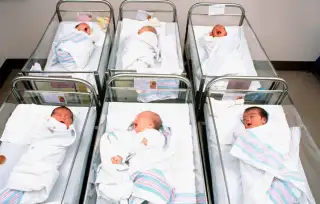The Government Will Pay You to Have Babies in These Countries

Would you have a baby, or add more children to your family, if the government cut you a check to help cover the bills? Government programs that pay parents financial incentives for having kids are popping up in more and more countries as a strategy to combat declining birth rates.
Demographers study birth rates as a measure of stability. Essentially, people will have children if they feel they have job security, a stable economy, and feel supported in starting a family. Dwindling population growth, on the other hand, can spell economic doom. Financial incentives and bonuses are one way to support parents and boost birth rates.
In one small municipality in Finland — Lestijärvi — birth rates were plunging. Only one child had been born per year before 2013, according to the BBC. Since then, local officials implemented a “baby bonus” in which each baby born is worth 10,000 euros, paid to the family over the course of 10 years.
Financial incentives for having children are increasingly appearing as a response to low birth rate numbers in places like Finland, Estonia, Italy, Japan, and Australia. Other ways to bolster birth rates include increased access to childcare, longer and better paid maternity/paternity leave, plus deconstructing traditional gender dynamics by empowering women to have jobs while also having children.
Finland also implements other family benefit programs like the baby box starter kit and a monthly allowance of 100 euros for parents.
In Estonia, families are rewarded for having more children. The larger the family the more money they receive. This, combined with other financial benefits and a year-long paid maternity leave, has helped birth rates to rise, and could be improving or at least stabilizing the economy.
Countries like China are struggling to recover from declining birth rates because of the one-child rule that was dismantled in 2016, according to The Guardian. For 37 years people were only allowed to have one child per household, but now the limit been raised to two.
More recently, Chinese policymakers have been considering implementing subsidies and incentives for parents to combat the declining birth rate.
Meanwhile, in recent years Japan hit its highest fertility rate in 21 years, according to Business Insider. The biggest improvements were found in areas that have implemented similar cash incentives for having children. In one town — Ama, on the island of Nakanoshima — parents are paid 100,000 yen ($940 USD) for their first child, but by the fourth could be paid up to 1 million yen (about $9,400 USD).
In the United States, fertility rates have hit a 32-year-low, according to a 2019 CDC study. But there have been no serious proposals floated to incentivize people to have children.
If such a program was ever implemented in the U.S., it would have to pay out enormous sums in order to cover the real cost of having a child. The U.S. Department of Agriculture reports that the average cost of raising a child to the age of 17 costs about $233,610 or about $14,000 per year.